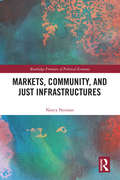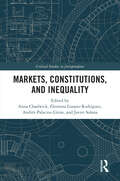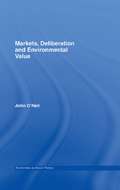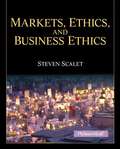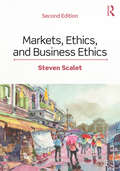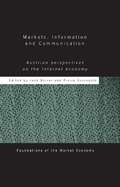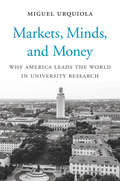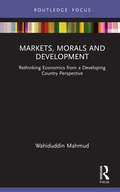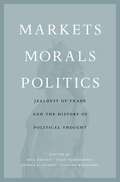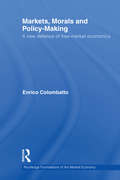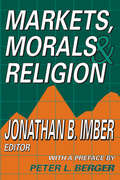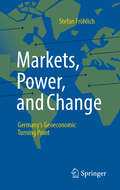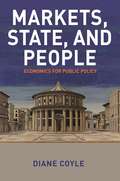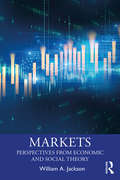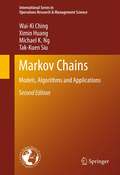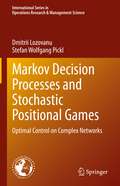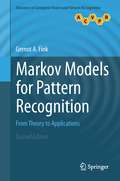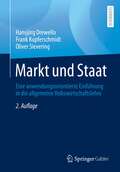- Table View
- List View
Markets, Community and Just Infrastructures (Routledge Frontiers of Political Economy)
by Nancy NeimanA series of market-related crises over the past two decades – financial, environmental, health, education, poverty – reinvigorated the debate about markets and social justice. Since then, counter-hegemonic movements all over the globe are attempting to redefine markets and the meaning of economic enterprise in people’s daily lives. Assessments of market outcomes tend toward the polemical, with capitalists and socialists, globalization advocates and anti-globalization movements, those on the political right and those on the left, all facing off to argue the benefits or harms brought about by markets. Yet not enough attention has been paid to analyzing the conditions under which markets result in just outcomes. This book explores how culture, politics, and ideology help shape market incentives in an attempt to reclaim the language of economic rationality and the policymaking legitimacy that accompanies it. Through a variety of case studies – labor relations in the U.S. meatpacking industry, the globalization process in Juaìrez, Mexico, financial reform in Cuba, and an interfaith Ugandan coffee cooperative – this book provides a framework for understanding the conditions under which markets promote just or unjust outcomes (e.g., discrimination, income inequality, environmental degradation, or racial justice, human rights, and equitable growth). This book touches on subject matter as varied as food, religion, banking, and race and gender equality, from a multi-disciplinary perspective. It offers an analysis of markets based on community rather than pure individualism that has the potential to change the way we think about economic rationality. An accessible and compelling read, this book will appeal to students and scholars in political science, economics, sociology, geography, gender studies, critical race studies, environmental studies, and all those interested in the critique of mainstream economics and neoliberal logic.
Markets, Constitutions, and Inequality (Critical Studies in Jurisprudence)
by Anna Chadwick, Eleonora Lozano-Rodríguez, Andrés Palacios-Lleras, and Javier SolanaThis interdisciplinary collection examines the significance of constitutions in setting the terms and conditions upon which market economies operate. With some important exceptions, most notably from the tradition of Latin American constitutionalism, scholarship on constitutional law has paid negligible attention to questions of how constitutions relate to economic phenomena. A considerable body of literature has debated the due limits of the exercise of executive and legislative power, and discussions about legitimacy, democracy, and the adjudication of rights (civil and political, and socioeconomic) abound, yet scant attention has been paid by constitutional lawyers to the ways in which constitutions may protect and empower economic actors, and to how constitutions might influence the regulation and governance of specific markets. The contributors to this collection mobilize insights from other disciplines – including economic theory, history, and sociology – and consider the relationship between constitutional frameworks and bodies of law – including property law, criminal law, tax law, financial regulation, and human rights law – to advance understanding of how constitutions relate to markets and to the political economy. This book’s analysis of the role constitutions play in shaping markets will appeal to scholars and students in law, economics, history, politics, and sociology.
Markets, Deliberation and Environment (Economics as Social Theory)
by John O'NeillWhat is the source of our environmental problems? Why is there in modern societies a persistent tendency to environmental damage? From within neoclassical economic theory there is a straightforward answer to those questions: it is because environmental goods and harms are unpriced. They come free. This position runs up against a view which runs in entirely the opposite direction, that our environmental problems have their source not in a failure to apply market norms rigorously enough, but in the very spread of these market mechanisms and norms. The source of environmental problems lies in part in the spread of markets both in real geographical terms across the globe and through the introduction of markets mechanisms and norms into spheres of life that previously have been protected from markets. In this book, John O’Neill conducts a thorough examination of these two opposing viewpoints covering a discussion of the ethical boundaries of markets, the role of private property rights in environmental protection, the nature of sustainability and the valuation of goods over time. This book is essential reading for undergraduate and postgraduate students studying courses in ecological and environmental economics.
Markets, Ethics, and Business Ethics
by Steve ScaletMarkets, Ethics, and Business Ethics provides an introductory discussion on basic, challenging concepts of business ethics: markets, property rights, law, and corporations.This title presents a balance of institutional perspectives and the concrete decisions people make within those institutions. The text studies the rules and incentives of a business system as well as the ethical decisions that people confront within their roles as consumers, investors, managers, owners, employees, and citizens.
Markets, Ethics, and Business Ethics (2nd Edition)
by Steven Scalet<p>This book introduces a study of ethics and values to develop a deeper understanding of markets, business, and economic life. Its distinctive feature is its thorough integration across personal and institutional perspectives; across applied ethics and political philosophy; and across philosophy, business, and economics. <p>Part 1 studies markets, property rights, and law, and introduces normative theories with many applications. Part 2 examines the purpose of corporations and their responsibilities. Parts 3 and 4 analyze business and economic life through the ethics and values of welfare and efficiency, liberty, rights, equality, desert, personal character, community, and the common good. <p>This second edition maintains the strengths of the first edition—short, digestible chapters and engaging writing that explains challenging ideas clearly. The material is user-friendly, with an emphasis on a strong theoretical core. Easily adaptable to the instructor’s teaching, the chapters are separable and can be shaped to the interests of the instructor with suggested course outlines and flexible application to case studies. This text is designed both for coursework in business ethics, as well as interdisciplinary programs in philosophy, politics, economics, and law. This second edition: <p> <li>revises presentation of eight normative theories, with increased emphasis on linksto business and economic life <li>incorporates recent scholarship on shareholder/stakeholder debates about the purpose of corporations, bringing this important topic up to date <li>includes a new, streamlined preface that provides a quick overview of the book before smoothly guiding the reader to the first chapter <li>uses updated examples and applications <li>revamps a useful appendix, including enhancing the popular primer on ethics <li>includes Key Terms, Discussion Questions, Biographies, and Lists of Further Readings at the end of each chapter <li>includes a new ending chapter on the value of an ethical life
Markets, Games, and Strategic Behavior: An Introduction to Experimental Economics
by Charles A. HoltEconomics is rapidly becoming a more experimental science, and the best way to convey insights from this research is to engage students in classroom simulations that motivate subsequent discussions and reading. In this expanded and updated second edition of Markets, Games, and Strategic Behavior, Charles Holt, one of the leaders in experimental economics, provides an unparalleled introduction to the study of economic behavior, organized around risky decisions, games of strategy, and economic markets that can be simulated in class. Each chapter is based on a key experiment, presented with accessible examples and just enough theory. <P><P> Featuring innovative applications from the lab and the field, the book introduces new research on a wide range of topics. Core chapters provide an introduction to the experimental analysis of markets and strategic decisions made in the shadow of risk or conflict. Instructors can then pick and choose among topics focused on bargaining, game theory, social preferences, industrial organization, public choice and voting, asset market bubbles, and auctions. <P><P> Based on decades of teaching experience, this is the perfect book for any undergraduate course in experimental economics or behavioral game theory. <P><P> New material on topics such as matching, belief elicitation, repeated games, prospect theory, probabilistic choice, macro experiments, and statistical analysis Participatory experiments that connect behavioral theory and laboratory research Largely self-contained chapters that can each be covered in a single class Guidance for instructors on setting up classroom experiments, with either hand-run procedures or free online software End-of-chapter problems, including some conceptual-design questions, with hints or partial solutions provided
Markets, Information and Communication: Austrian Perspectives on the Internet Economy (Routledge Foundations Of The Market Economy Ser.)
by Jack Birner Pierre GarrousteThe internet bubble which peaked in size in 2000 is now well and truly burst. As with all bubbles, there are varying explanations for its occurrence, but the hype which surrounds the internet has shouldered a lot of the blame. There is however, no doubt that the internet has significantly changed the way people live, think and do business.This impr
Markets, Minds, and Money: Why America Leads the World in University Research
by Miguel UrquiolaA colorful history of US research universities, and a market-based theory of their global success. American education has its share of problems, but it excels in at least one area: university-based research. That’s why American universities have produced more Nobel Prize winners than those of the next twenty-nine countries combined. Economist Miguel Urquiola argues that the principal source of this triumph is a free-market approach to higher education. Until the late nineteenth century, research at American universities was largely an afterthought, suffering for the same reason that it now prospers: the free market permits institutional self-rule. Most universities exploited that flexibility to provide what well-heeled families and church benefactors wanted. They taught denominationally appropriate materials and produced the next generation of regional elites, no matter the students’—or their instructors’—competence. These schools were nothing like the German universities that led the world in research and advanced training. The American system only began to shift when certain universities, free to change their business model, realized there was demand in the industrial economy for students who were taught by experts and sorted by talent rather than breeding. Cornell and Johns Hopkins led the way, followed by Harvard, Columbia, and a few dozen others that remain centers of research. By the 1920s the United States was well on its way to producing the best university research. Free markets are not the solution for all educational problems. Urquiola explains why they are less successful at the primary and secondary level, areas in which the United States often lags. But the entrepreneurial spirit has certainly been the key to American leadership in the research sector that is so crucial to economic success.
Markets, Morals and Development: Rethinking Economics from a Developing Country Perspective
by Wahiduddin MahmudThis book presents, or rather ‘re-presents’, the intricacies of a developing economy in the light of recent theoretical developments in economics while also providing a fresh perspective on the perceived inadequacies of the discipline in addressing the discontents of the contemporary global economic order. The book argues that there is scope for economics to be a more humane discipline and more relevant to contemporary economic problems by embracing new ideas, including those from other disciplines. It shows how economic concepts including recent theoretical advances can help better understand real life economic phenomena; to rethink the ways of making the market economy address the moral issues of human well-being and social justice and; overall, how the study of economics at an introductory level and public discourses on economic issues can be made more engaging as well as more relevant to the problems of developing countries. Based on public lectures given by the author in Dhaka, and using illustrations from Bangladesh, India and other countries, the book offers an authoritative understanding of diverse economic realities by taking a fresh look at the familiar. Comprehensive and accessible, the book will be of interest to students and researchers of economics, development economics and policy, sociology and business studies as well as journalists, public intellectuals and policymakers in developing countries.
Markets, Morals, Politics: Jealousy of Trade and the History of Political Thought
by Béla KapossyWhen István Hont died in 2013, the world lost a giant of intellectual history. A leader of the Cambridge School of Political Thought, Hont argued passionately for a global-historical approach to political ideas. To better understand the development of liberalism, he looked not only to the works of great thinkers but also to their reception and use amid revolution and interstate competition. His innovative program of study culminated in the landmark 2005 book Jealousy of Trade, which explores the birth of economic nationalism and other social effects of expanding eighteenth-century markets. Markets, Morals, Politics brings together a celebrated cast of Hont’s contemporaries to assess his influence, ideas, and methods. Richard Tuck, John Pocock, John Dunn, Raymond Geuss, Gareth Stedman Jones, Michael Sonenscher, John Robertson, Keith Tribe, Pasquale Pasquino, and Peter N. Miller contribute original essays on themes Hont treated with penetrating insight: the politics of commerce, debt, and luxury; the morality of markets; and economic limits on state power. The authors delve into questions about the relationship between states and markets, politics and economics, through examinations of key Enlightenment and pre-Enlightenment figures in context—Hobbes, Rousseau, Spinoza, and many others. The contributors also add depth to Hont’s lifelong, if sometimes veiled, engagement with Marx. The result is a work of interpretation that does justice to Hont’s influence while developing its own provocative and illuminating arguments. Markets, Morals, Politics will be a valuable companion to readers of Hont and anyone concerned with political economy and the history of ideas.
Markets, Morals, and Policy-Making: A New Defense of Free-Market Economics (Routledge Foundations Of The Market Economy Ser. #30)
by Enrico ColombattoFree-market economics has attempted to combine efficiency and freedom by emphasizing the need for neutral rules and meta-rules. These efforts have only been partly successful, for they have failed to address the deeper, normative arguments justifying – and limiting – coercion. This failure has thus left most advocates of free-market vulnerable to formulae which either emphasize expediency or which rely upon optimal social engineering to foster different notions of the common will and of the common good. This book offers the reader a new perspective on free-market economics, one in which the defense of markets is no longer based upon the utilitarian claim that free markets are more efficient; rather, the defense of markets rests upon the moral argument that top-down coercive policy-making is necessarily in tension with the rights-based notion of justice typical of the Western tradition. In arguing for a consistent moral basis for the free-market view, we depart from both the Austrian and neoclassical traditions by acknowledging that rationality is not a satisfactory starting point. This rejection of rationality as the complete motivator for human economic behaviour throws constitutional economics and the law-and-economics tradition into new relief, revealing these approaches as governed by considerations derived by various notions of social efficiency, rather than by principles consistent with individual freedom, including freedom to choose. This book shows that the solution is in fact a better understanding of the lessons taught by the Scottish Enlightenment: the role of the political context is to ensure that the individual can pursue his own ends, free from coercion. This also implies individual responsibility, respect for somebody else’s preferences and for his entrepreneurial instincts. Social virtue is not absent from this understanding of politics, but rather than being defined through the priorities of policy-makers, it emerges as the outcome of interaction among self-determining individuals. The strongest and most consistent case for free-market economics, therefore, rests on moral philosophy, not on some version of static-efficiency theorizing. This book should be of interest to students and researchers focussing on economic theory, political economics and the philosophy of economic thought, but is also written in a non-technical style making it accessible to an audience of non-economists.
Markets, Morals, and Religion
by Peter L. Berger Jonathan B. ImberThe examination of the relationship of economic activity to other important aspects of human life and social behavior has inspired some of the most interesting and provocative social-scientific research in the past one hundred years. This book of original essays by leading thinkers across many disciplines offers new insights into enduring questions about how modern and modernizing market economies are both shaped by and shapers of morality, values, and religion.Part 1, "Markets and Morals," offers eight contributors who provide analyses of the various ways in which the market operates in relation to morality. An empirical presentation of moral values and market attitudes is given. Other essays take aim at how markets serve and disserve moral interests: Economic growth has moral consequences; the manipulation of markets exposes a moral underside; the nature of market failure has implications for understanding moral vulnerability; preference change has moral implications. In other chapters, a broad consideration of the positive moral effects of market economies is offered along with historical essays on the role that intellectuals have played in debates about the positive and negative effects of commercial life and on the ways in which the American idea of the pursuit of happiness reveals much about the morality of economic life.In Part 2, "Markets and Religion," nine contributors address both the historical and contemporary emergence of religious factors in the growth and transformation of global capitalism. Major religious traditions, including Judaism, Christianity, and Islam are examined for their contributions to answering questions about the nature and function of economic life in light of religious ideas and ideals. Several essays present original approaches to the importance of religious values to modern forms of consumption and to the political economy of reconciliation and forgiveness in nations coming to terms with past conflict. Finally, t
Markets, Power, and Change: Germany's Geoeconomic Turning Point
by Stefan FröhlichWhile the issue of Ukraine is engaging the public and fostering a greater interest in foreign and security policy topics, global economic policy issues and debates largely pass most people by and are primarily discussed by economists and economic historians. Unlike during the Euro crisis, whose complexities overwhelmed society as a whole, questions about supply chains, resource security, and technological change have now reached the press and media. However, for most people, the necessity of a related paradigm shift in German foreign and economic policy is not evident. This is particularly true for the increasing importance of using economic means to enforce (power) political interests – in other words, the new "geoeconomics". This book situates the scientific findings and debates surrounding this term within the global confrontation between the USA, China, and Europe, translating them into language that everyone can understand. The author contributes to the public debate in Germany with this essay and therefore addresses the interested public.
Markets, State, and People: Economics for Public Policy
by Diane CoyleA textbook that examines how societies reach decisions about the use and allocation of economic resourcesWhile economic research emphasizes the importance of governmental institutions for growth and progress, conventional public policy textbooks tend to focus on macroeconomic policies and on tax-and-spend decisions. Markets, State, and People stresses the basics of welfare economics and the interplay between individual and collective choices. It fills a gap by showing how economic theory relates to current policy questions, with a look at incentives, institutions, and efficiency. How should resources in society be allocated for the most economically efficient outcomes, and how does this sit with society’s sense of fairness?Diane Coyle illustrates the ways economic ideas are the product of their historical context, and how events in turn shape economic thought. She includes many real-world examples of policies, both good and bad. Readers will learn that there are no panaceas for policy problems, but there is a practical set of theories and empirical findings that can help policymakers navigate dilemmas and trade-offs. The decisions faced by officials or politicians are never easy, but economic insights can clarify the choices to be made and the evidence that informs those choices. Coyle covers issues such as digital markets and competition policy, environmental policy, regulatory assessments, public-private partnerships, nudge policies, universal basic income, and much more.Markets, State, and People offers a new way of approaching public economics.A focus on markets and institutionsPolicy ideas in historical contextReal-world examplesHow economic theory helps policymakers tackle dilemmas and choices
Markets, Unemployment and Economic Policy: Essays in Honour of Geoff Harcourt, Volume Two (Routledge Frontiers of Political Economy #Vol. 7)
by Philip Arestis Malcolm Sawyer Gabriel PalmaIn this volume more than 40 leading economists pay tribute to, and critically evaluate, Geoff Harcourt's work. Contributors include Tony Atkinson, Tony Lawson, Edward Nell and Ian Steedman.
Markets: Perspectives from Economic and Social Theory (Economics as Social Theory)
by William A. JacksonDefining markets has never been an easy task. Despite their importance for economic theory and practice, they are hard to pin down as a concept and economists have tended to adopt simplified axiomatic models or rely on piecemeal case studies. This book argues that an extended range of theory, social as well as economic, can provide a better foundation for the portrayal of markets. The book first looks at the definition of markets, their inadequate treatment in orthodox economic theory, and their historical background in the pre-capitalist and capitalist eras. It then assesses various alternatives to orthodox theory, categorised as social/cultural, structural, functional and ethical approaches. Among the alternatives considered are institutionalist accounts, Marxian views, network models, performativity arguments, field theories, Austrian views and ethical notions of fair trade. A key finding of the book is that these diverse approaches, valuable as they are, could present a more effective challenge to orthodoxy if they were less disparate. Possibilities are investigated for a more unified theoretical alternative to orthodoxy. Unlike most studies of markets, this book adopts a fully interdisciplinary viewpoint expressed in accessible, non-technical language. Ideas are brought together from heterodox economics, social theory, critical realism, as well as other social sciences such as sociology, anthropology and geography. Anybody seeking a broad critical survey of the theoretical analysis of markets will find this book useful and it will be of great interest to economists, social scientists, students and policy-makers.
Markov Chains
by Michael K. Ng Wai-Ki Ching Tak-Kuen Siu Ximin HuangThis new edition of Markov Chains: Models, Algorithms and Applications has been completely reformatted as a text, complete with end-of-chapter exercises, a new focus on management science, new applications of the models, and new examples with applications in financial risk management and modeling of financial data. This book consists of eight chapters. Chapter 1 gives a brief introduction to the classical theory on both discrete and continuous time Markov chains. The relationship between Markov chains of finite states and matrix theory will also be highlighted. Some classical iterative methods for solving linear systems will be introduced for finding the stationary distribution of a Markov chain. The chapter then covers the basic theories and algorithms for hidden Markov models (HMMs) and Markov decision processes (MDPs). Chapter 2 discusses the applications of continuous time Markov chains to model queueing systems and discrete time Markov chain for computing the PageRank, the ranking of websites on the Internet. Chapter 3 studies Markovian models for manufacturing and re-manufacturing systems and presents closed form solutions and fast numerical algorithms for solving the captured systems. In Chapter 4, the authors present a simple hidden Markov model (HMM) with fast numerical algorithms for estimating the model parameters. An application of the HMM for customer classification is also presented. Chapter 5 discusses Markov decision processes for customer lifetime values. Customer Lifetime Values (CLV) is an important concept and quantity in marketing management. The authors present an approach based on Markov decision processes for the calculation of CLV using real data. Chapter 6 considers higher-order Markov chain models, particularly a class of parsimonious higher-order Markov chain models. Efficient estimation methods for model parameters based on linear programming are presented. Contemporary research results on applications to demand predictions, inventory control and financial risk measurement are also presented. In Chapter 7, a class of parsimonious multivariate Markov models is introduced. Again, efficient estimation methods based on linear programming are presented. Applications to demand predictions, inventory control policy and modeling credit ratings data are discussed. Finally, Chapter 8 re-visits hidden Markov models, and the authors present a new class of hidden Markov models with efficient algorithms for estimating the model parameters. Applications to modeling interest rates, credit ratings and default data are discussed. This book is aimed at senior undergraduate students, postgraduate students, professionals, practitioners, and researchers in applied mathematics, computational science, operational research, management science and finance, who are interested in the formulation and computation of queueing networks, Markov chain models and related topics. Readers are expected to have some basic knowledge of probability theory, Markov processes and matrix theory.
Markov Decision Processes and Stochastic Positional Games: Optimal Control on Complex Networks (International Series in Operations Research & Management Science #349)
by Dmitrii Lozovanu Stefan Wolfgang PicklThis book presents recent findings and results concerning the solutions of especially finite state-space Markov decision problems and determining Nash equilibria for related stochastic games with average and total expected discounted reward payoffs. In addition, it focuses on a new class of stochastic games: stochastic positional games that extend and generalize the classic deterministic positional games. It presents new algorithmic results on the suitable implementation of quasi-monotonic programming techniques. Moreover, the book presents applications of positional games within a class of multi-objective discrete control problems and hierarchical control problems on networks. Given its scope, the book will benefit all researchers and graduate students who are interested in Markov theory, control theory, optimization and games.
Markov Models for Pattern Recognition
by Gernot A. FinkThis thoroughly revised and expanded new edition now includes a more detailed treatment of the EM algorithm, a description of an efficient approximate Viterbi-training procedure, a theoretical derivation of the perplexity measure and coverage of multi-pass decoding based on n-best search. Supporting the discussion of the theoretical foundations of Markov modeling, special emphasis is also placed on practical algorithmic solutions. Features: introduces the formal framework for Markov models; covers the robust handling of probability quantities; presents methods for the configuration of hidden Markov models for specific application areas; describes important methods for efficient processing of Markov models, and the adaptation of the models to different tasks; examines algorithms for searching within the complex solution spaces that result from the joint application of Markov chain and hidden Markov models; reviews key applications of Markov models.
Markov Processes (Advances in Applied Mathematics)
by James R. KirkwoodClear, rigorous, and intuitive, Markov Processes provides a bridge from an undergraduate probability course to a course in stochastic processes and also as a reference for those that want to see detailed proofs of the theorems of Markov processes. It contains copious computational examples that motivate and illustrate the theorems. The text is desi
Marks & Spencer: The Phoenix Rises
by Joseph L. BowerThe great U.K. retailer fell on hard times in 1998. In 2001, a new CEO was recruited who appears to have succeeded in turning around this world-renown company. This case examines the steps he took (strategic, structural, and recruiting key people) and highlights a series of fundamental questions that remain. Can the company regain its premium retail brand given the new competition and given the breadth of market segments that it addresses under one roof? Are the new approaches to sourcing and segmentation sound? Should the firm seriously consider reentering the international retail markets?
Marks & Spencer: The Phoenix Rises
by Joseph L. BowerThe great U.K. retailer fell on hard times in 1998. In 2001, a new CEO was recruited who appears to have succeeded in turning around this world-renown company. This case examines the steps he took (strategic, structural, and recruiting key people) and highlights a series of fundamental questions that remain. Can the company regain its premium retail brand given the new competition and given the breadth of market segments that it addresses under one roof? Are the new approaches to sourcing and segmentation sound? Should the firm seriously consider reentering the international retail markets?
Marks and Spencer Ltd. (A)
by Cynthia A. MontgomeryMarks and Spencer is a highly regarded retailer in the United Kingdom. This case examines the history of the firm, its organizational capabilities, and its long standing relationships with employees, customers, and suppliers. Also discusses the firm's expansion into Europe and Canada. May be used with Marks and Spencer Ltd. (B).
Marks and Spencer Ltd. (B)
by Cynthia A. Montgomery Dianna MagnaniDescribes the firm's 1988 expansion into the United States through the acquisition of Brooks Brothers, a specialty up-market men's clothing chain and Kings Super Markets, a high quality New Jersey grocer.
Markt und Staat: Eine anwendungsorientierte Einführung in die allgemeine Volkswirtschaftslehre
by Hansjörg Drewello Frank Kupferschmidt Oliver SieveringDieses Buch bietet einen kompakten und inhaltlich fundierten Überblick über die zentralen Grundlagen der Volkswirtschaftslehre. Es eignet sich besonders als begleitende Lektüre für Veranstaltungen zur Einführung in diesen Themenbereich.Der Staat und seine Bediensteten sind entscheidende Akteure in jeder Volkswirtschaft. Sie beeinflussen die Rahmenbedingungen des Wirtschaftsgeschehens, regulieren Marktversagen und sind selbst Produzent und Konsument. Um der staatlichen Verantwortung für eine zukunftsfähige Gesellschaft auf allen Ebenen zielgerichtet und effizient gerecht werden zu können, ist ein grundlegendes Verständnis ökonomischer Zusammenhänge unabdingbar. Anhand der wichtigsten mikroökonomischen Grundlagen erläutert dieses Buch die ökonomischen Rahmenbedingungen und Möglichkeiten von Märkten. Makroökonomisches Grundwissen hilft den Studierenden dabei, Bezüge zur Wirtschaftspolitik herstellen zu können. Die Autoren arbeiten die besondere Rolle des Staates in der Marktwirtschaft heraus und liefern so gerade angehenden Beamtinnen und Beamten grundlegende Kenntnisse über die ökonomischen Auswirkungen staatlichen Handelns.Ergänzt durch Wiederholungsaufgaben und Lösungsvorschläge, stellt das Buch insbesondere beim Erstkontakt mit volkswirtschaftlichen Fragestellungen eine anwendungsbezogene Orientierungshilfe dar. Für die neue Auflage wurde das Buch komplett überarbeitet und um einen Übungsteil mit acht beispielhaften Übungsklausuren und den dazugehörigen Lösungen erweitert.
